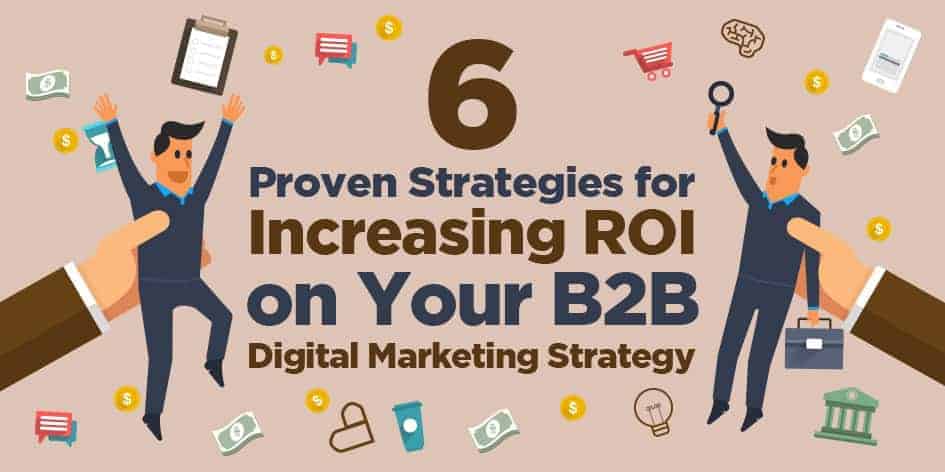The internet has touched nearly every part of our day-to-day lives – and that, as B2B marketers know all too well, includes the purchasing process.
Gone are the days when a company had to learn everything they wanted to know about a supplier or vendor from a salesperson.
Now, companies can – and do – get most of their information from a website. They can eliminate vendors from their shortlists without even contacting them – which means that vendors may not even know they were ever in the running.
In fact, according to data from the Harvard Business Review, customers today are an average of 57 percent of the way through the purchase process before they engage with salespeople.
This is a serious disruption of the way B2B sales used to be accomplished.
While salespeople are still vital when it comes to refining and closing a deal, B2B companies are having to differentiate themselves from the crowd earlier on in the customer journey. This puts more pressure on B2B marketers.
So how can you improve your B2B marketing strategies so that you can attract more customers at the outset, and keep them interested throughout the purchase process? Here are 6 proven strategies.
Invest more in your blog.
Believe it or not, your blog is one of the most powerful inbound marketing tools your company has at its disposal. According to Hubspot, B2B companies that blog generate 67% more leads than companies that do not.
Since leads are everything in B2B industries, you can’t afford not to be putting up fresh, valuable blog posts on a regular basis.
Your blog is one of the most powerful inbound marketing tools your company has at its disposal. Share on XSo how do you start investing in your blog?
As with most things, it’s quality that matters here more than quantity. One solid blog post full of information your customers can actually use is worth much, much more than five short posts that offer vague opinions and not much else.
What you should be aiming for in a blog post is a long-form piece (at least 1,200 to 1,600 words) that includes at least a few nuggets of hard data to support your claims – unless the piece you’re writing is pure opinion, which also has its place.
Statistics, screenshots, in-depth instructions, embedded tweets, images – a great post will have at least one, and preferably more, of these elements. And it goes without saying that every blog post should be well-written: concise, clear, and interesting to read.
If you’re already focusing on writing long-form content, then you may want to turn your attention to up the frequency at which you post.
If you’re getting up 2 blog posts per month, shoot for 3 or 4. If you’re posting 1 per week, try and up that to 2. That might involve hiring freelancers to do some of the writing for you. It might involve hiring a digital marketing agency. It might involve establishing your own in-house content team.
Whatever you do to you’ll see your site traffic skyrocket as you post more frequently, and better yet, the traffic you get will be more high-quality.
Balance your gated and ungated content.
Gated content is a must for B2B companies, but you have to know how and when to use it. Gate too much, and it can put off potential customers; gate too little, and you’ll miss out on lots of potential leads.
Gated content is a must for B2B companies, but you have to know how and when to use it. Share on XWe wrote a whole blog post on how to use gated content wisely, so check that out if you need help. But here are a few brief pointers.
- When deciding whether to gate your content, consider who the gate may keep out as well as what information it will bring in.
- Remember you can gate in several ways: you can keep it simple, and just ask for an email address, or you can up the stakes a bit and request information like name, company, phone number, etc. You can even require people to pay.
- Realize that gated content isn’t accessible by search bots, so it has little to no SEO value.
Ramp up your B2B email marketing.
There have been all kinds of alarmist cries about B2B email marketing over the past five years or so. At various points, it’s been called dead or dying, useless, a waste of precious resources… you get the picture.
However, don’t buy into those ideas. The truth is that email marketing is still one of the most effective ways to communicate with customers.
Why?
Because every customer on your email list has signed up to receive emails from you. That means that everyone, or nearly everyone, on your list should actually receive that email. Even if they delete it immediately, they may glance at the sender for a moment beforehand.
The truth is that email marketing is still one of the most effective ways to communicate with customers. Share on XWith a social media post, on the other hand, a big chunk of your audience may never see it. Social media posts also don’t give you the robust stats that emails do.
Email marketing is especially important for B2B companies, partly because it’s incredibly cost-effective. According to the Direct Marketing Association, the average ROI on email marketing is 40:1.
The most effective thing you can do to improve your email marketing is to improve your targeting. When you have your targeting right, your open and click-through rates will improve automatically. That’s because the people who get your emails will actually be people who want your emails.
The way you improve your targeting is by segmenting your audience. You can do this in all kinds of ways. Here are just a few ideas of ways to segment:
- Segment based on when customers last completed a purchase
- Segment according to average click-through rate
- Segment based on email open rates, so that people who haven’t opened your emails in a while get a reminder or “reactivation” email
Don’t ask for too much information too early in the customer journey.
Just as you need to strike a balance between gated and ungated content on your site, you need to be careful about the amount of information you request from potential customers up front.
Ideally, you want just enough information to allow you to move a customer along to the next step, without putting them off by appearing to make a hard sell. It’s fairly basic – after all, customers have abhorred the hard sell for as long as there have been salespeople – but it’s still worth looking at on your own site.
If you really want to streamline your information-gathering, consider implementing marketing automation software.
Many of these software suites offer something called progressive profiling, which is a method of requesting information from customers through a series of steps, each initiated by a customer taking a specific action.
This can reduce the frequency of people getting put off or frustrated by being required to fill out extensive forms for a content asset, or give up their email address before they’re ready.
Develop buyer personas.
If you haven’t developed buyer personas yet, you’re missing out on a highly valuable tool that can greatly increase the power of your marketing.
Buyer personas are specific descriptions of a hypothetical customer. The more detailed you can be, the more effective the persona in influencing your marketing.
For example, a buyer persona for a nutrition bar company could look something like this:
- Name: Mary
- Age: 32
- Demographics: Married, 2 children, college-educated, suburban lifestyle.
- Household income level: $95,000-$110,000
- Fitness level: Moderate – exercises 2 to 3 times per week, mainly cardio. More focused on feeling healthy than on looking fit.
Of course, you could go into more areas, too – interests, the kind of media they use, etc. All of this will help you target your marketing more effectively.
For B2B companies, buyer personas can be a little more complicated because you’re often working with a buying team, rather than a single individual buyer.
However, you can still create an effective persona by focusing more on the problem that the buying team – specifically the buying team director – is looking to solve, than the demographics of the buyer.
That would include categories like:
- Job title
- Length of time in the job
- Role and responsibilities
- Daily needs
- Long-term needs
- Frustrations
- Likes/dislikes about job
Once you’ve developed a few of these, you’ll have a better idea of where and how to target your marketing so it reaches the right people.
Measure your results and pivot as necessary.
We all know that analytics are a vital part of any digital marketing strategy. But what use are analytics if you don’t act on what they’re telling you?
Perhaps the hardest part of marketing in the digital age is being willing to scrap an idea when it’s not giving you the results you want.
For your marketing efforts to be successful, you have to listen to what the data is telling you. Then you have to adapt your efforts accordingly – even if that means doing something totally new, something you’d never even considered doing before.
This requires courage. But if you commit to being courageous with your B2B marketing efforts, you’ll absolutely see results.









